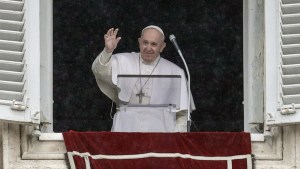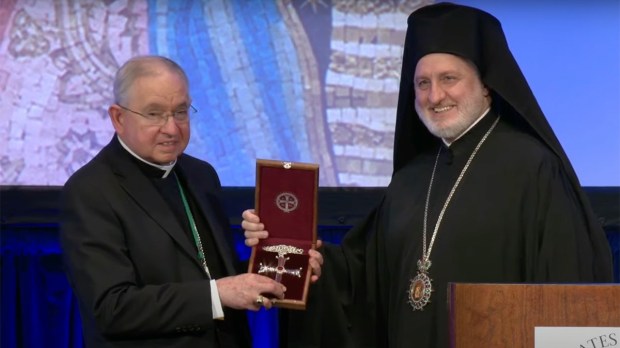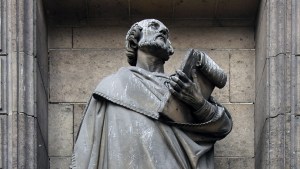The autumn meeting of the United States Conference of Catholic Bishops this past week witnessed a tender moment of brotherhood — not only among more than 230 bishops who gathered in person for the first time since the beginning of the coronavirus pandemic, but also between bishops from the still divided Churches of the Christian world.
At the center of that encounter was a symbol that should unite all Christians: the cross of Christ.
In a historic first, Greek Orthodox Archbishop Elpidophoros addressed the USCCB Fall General Assembly, held in Baltimore November 15-18. Elpidophoros is the primate of the Greek Orthodox Archdiocese of America, but came in his capacity as Chairman of the Assembly of Canonical Orthodox Bishops of the United States. He was accompanied by several primates of other Orthodox Churches in North America.
Elpidophoros, 53, who recently hosted a visit from the Ecumenical Patriarch Bartholomew I of Constantinople, the “First Among Equals” in the Orthodox communion, was invited to address the US Catholic bishops’ conference by its president, Los Angeles Archbishop José H. Gomez.
At the end of his speech on Tuesday, Epidophoros presented Gomez with a silver pectoral cross, as a sign of his “love and appreciation.” The cross was made in Istanbul, modeled on one from that city’s most famous monument, the Hagia Sophia Cathedral.
“The cross, a personal gift from Archbishop Elpidophoros, is inspired by the Justinian cross (also known as the cross of Hagia Sophia),” a spokesman from the New York-based Greek Orthodox Archdiocese of America told Aleteia. “This specific cross is crafted by an Orthodox Christian jeweler in Istanbul.”
But the Greek Orthodox bishop, himself a native of Istanbul, never referred to the city with its current, Turkish name, using instead the historic name of the capital of the Eastern Roman Empire, Constantinople. He called Hagia Sophia, which has not served as a Christian house of worship for centuries and is now a mosque, as the “universal cathedral of Christianity, the cathedral of our unity.” Hagia Sophia — which is Greek for Holy Wisdom, referring to the Logos, the Second Person of the Trinity — served as the seat of the Archbishop of Constantinople when East and West were still in communion. One of those archbishops of Constantinople was St. John Chrysostom, who is venerated by both the Orthodox and Catholics.
It is toward that communion that the Catholic and Orthodox Churches have been striving for decades, and Epidophoros gave an overview of the work that’s been done on the American front in that struggle since the early days following the Second Vatican Council.
It was the historic meeting in Jerusalem — the place of the Cross — between Bartholomew’s predecessor, Ecumenical Patriarch Athenagoras, and Pope St. Paul VI that kicked that ecumenical movement into high gear. The meeting led then to the removal of the mutual excommunications of 1054, the so-called Great Schism.
Epidophoros noted that the North American Orthodox-Catholic Theological Consultation since 1965 has produced 32 documents, reports, and statements, some of which, he said, have become “real references for theologians, and for our Churches to walk together towards unity.”
The fruits of this dialogue, he pointed out, are not restricted to theological debate. Every year, the Assembly of Canonical Orthodox Bishops of the United States, together with Catholic Bishops, offer the opening prayer at the March for Life. And just a few months ago, the Assembly of Orthodox Bishops and the USCCB filed an amicus brief in the Dobbs v Jackson case that challenges Roe v Wade and will be heard by the Supreme Court December 1.
Synodal Churches
Elpidophoros no doubt had been listening to another presentation at the Bishops’ Conference meeting Tuesday morning, when Archbishop Christophe Pierre, papal nuncio to the United States, outlined Pope Francis’ hopes to guide the Catholic Church toward greater “synodality,” a decision-making process that involves deep listening to the Holy Spirit and to persons of different viewpoints. The word synod would surely resonate with a Greek Orthodox bishop, since it comes from the Greek language (it means “to be on the journey together”) and because Orthodox Churches are synodal Churches — i.e., governed by their primates in communion with his synod of bishops.
“As Orthodox Christians, we are also very interested in the work and the process of the next Catholic Synod of Bishops, which is scheduled for October 2023 and which will deal with ‘For a Synodal Church Community: Communion, Participation and Missions,’” Elpidophoros said in his USCCB speech. “During this two-year period, I believe that there is room for your ecumenical partners to provide input into the preparation process. This idea was recently shared by His Eminence Cardinal Kurt Koch, president of the Pontifical Council for Promoting Christian Unity.
“I am convinced that the future and mission of Catholic-Orthodox relations in the USA is to continue to bear witness to God’s presence in the world, faithful to the Spirit of Jerusalem that we received as a legacy,” Elpidophoros continued. “Ecumenical dialogue bears in itself a synodal dimension that explores the meaning and praxis of the very nature of the Church structure and mission. We know that international dialogue is already examining this issue through study of the interdependence between synodality and primacy [referring to the role of the Bishop of Rome]. But perhaps, in our American context, as we dedicate our energy and time to sharing this important issue and reflecting together, it will bear fruit in due course.”
He echoed Patriarch Bartholomew’s word, delivered during a visit last month to the National Council of Churches: “the future of the ecumenical movement resides in ‘the dialogue of love’ through the creation of new symbols and common actions. We need to open our hearts to the language of dialogue. This is the ultimate condition for the restoration of unity among Christians.”
“Our dialogue of love should be fashioned by the dialogue and inspiring relationship between our primates: His Holiness Pope Francis and His All-Holiness Ecumenical Patriarch Bartholomew. Ecumenical Patriarch Bartholomew was the first Archbishop of Constantinople to attend a Pope’s enthronement in 2013. They both share the same concern for the protection of the natural environment.”
As Elpidophos sat down, Archbishop Gomez, clearly admiring the Justinian Cross, placed its long silver chain around his neck, wearing the gift along with his own pectoral cross. “Perhaps you can teach me” how to wear it, he suggested to the speaker. He then thanked the Orthodox visitor for his words and expressed his hope that they will be able to continue their friendship and relationship “for the good of the Church and the world.”



